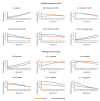Impact of Alcohol-Induced Facial Flushing Phenotype on Alcohol Consumption Among Korean Adults: 2-Year Cross-Sectional Study
- PMID: 38796304
- PMCID: PMC11325126
- DOI: 10.2196/49826
Impact of Alcohol-Induced Facial Flushing Phenotype on Alcohol Consumption Among Korean Adults: 2-Year Cross-Sectional Study
Abstract
Background: The alcohol-induced facial flushing phenotype (flushing) is common among East Asians. Despite a small intake of alcohol, they experience heightened levels of acetaldehyde, a group-1 carcinogen, which, in turn, causes unpleasant symptoms such as redness, acting as a robust protective mechanism against consuming alcohol. However, some individuals with this genetic trait exhibit weakened alcohol restraint, which increases the risk of developing alcohol-related cancers, such as esophageal and head or neck cancer, by several times. Although this flushing phenomenon is crucial for public health, there is a paucity of studies that have comprehensively investigated the effect of flushing or its genotype on alcohol consumption in a large group of East Asians while controlling for various sociodemographic and health-related variables at a country level.
Objective: This 2-year cross-sectional study aims to explore the effect of flushing on drinking behavior in Koreans and to examine whether the effect varies across sociodemographic and health-related factors.
Methods: We used data from the Korea National Health and Nutrition Examination Survey (KNHANES) for 2019 and 2020 conducted by the Korea Disease Control and Prevention Agency. Our sample comprised 10,660 Korean adults. The study investigated the association of 26 variables, including flushing, with drinking frequency and amount. The effect of flushing was examined with and without adjusting for the other 25 variables using multinomial logistic regression analysis. In addition, we tested the interaction effect with flushing and conducted a simple effect analysis. We used complex sample design elements, including strata, clusters, and weights, to obtain unbiased results for the Rao-Scott χ2 test, 2-tailed t test, and multinomial logistic regression analysis.
Results: The suppressive effect of flushing was significant (P<.001) across all pronounced categories of alcohol consumption in 2019. The ranges of standardized regression slopes and odds ratios (ORs) were -6.70≥β≥-11.25 and 0.78≥OR≥0.50 for frequency and -5.37≥β≥-17.64 and 0.73≥OR≥0.36 for amount, respectively. The effect became somewhat stronger when adjusted for confounders. The effect also exhibited an overall stronger trend as the severity of alcohol consumption increased. The β values and ORs were consistently smaller in 2020 compared to the previous year. A simple effect analysis revealed a diminished alcohol-suppressive effect of flushing on alcohol consumption for specific groups (eg, those with low levels of education, limited family support, physical labor, or health-related issues).
Conclusions: Our findings suggest that flushing suppresses drinking in Koreans overall but has little or no effect in certain susceptible populations. Therefore, health authorities should conduct targeted epidemiological studies to assess drinking patterns and disease profiles, particularly regarding alcohol-related cancers, and establish effective preventive measures tailored to this population.
Keywords: East Asian; acetaldehyde; alcohol; alcohol consumption; aldehyde dehydrogenase 2 polymorphism; drinking behavior; facial flushing.
©Bossng Kang, Changsun Kim, Seon-Hi Shin, Hyungoo Shin, Yongil Cho. Originally published in JMIR Public Health and Surveillance (https://publichealth.jmir.org), 31.07.2024.
Conflict of interest statement
Conflicts of Interest: None declared.
Figures

Similar articles
-
Epidemiologic relationship between alcohol flushing and smoking in the Korean population: the Korea National Health and Nutrition Examination Survey.Sci Rep. 2024 Jul 8;14(1):15710. doi: 10.1038/s41598-024-66521-z. Sci Rep. 2024. PMID: 38977782 Free PMC article.
-
Association between changes in facial flushing and hypertension across drinking behavior patterns in South Korean adults.J Clin Hypertens (Greenwich). 2022 May;24(5):611-620. doi: 10.1111/jch.14475. Epub 2022 Apr 19. J Clin Hypertens (Greenwich). 2022. PMID: 35437944 Free PMC article.
-
Effect of alcohol consumption on risk of hypertension based on alcohol-related facial flushing response: From the health examinees study.Alcohol. 2024 Dec;121:133-139. doi: 10.1016/j.alcohol.2024.02.010. Epub 2024 Mar 1. Alcohol. 2024. PMID: 38432421
-
Alcohol and aldehyde dehydrogenase polymorphisms and a new strategy for prevention and screening for cancer in the upper aerodigestive tract in East Asians.Keio J Med. 2010;59(4):115-30. doi: 10.2302/kjm.59.115. Keio J Med. 2010. PMID: 21187698 Review.
-
Genetic polymorphisms of alcohol and aldehyde dehydrogenases and risk for esophageal and head and neck cancers.Jpn J Clin Oncol. 2003 Mar;33(3):111-21. doi: 10.1093/jjco/hyg026. Jpn J Clin Oncol. 2003. PMID: 12672787 Review.
Cited by
-
Incorporating genetic variations in alcohol-associated liver disease trials for East Asian populations.Nat Rev Gastroenterol Hepatol. 2025 May;22(5):357. doi: 10.1038/s41575-025-01060-0. Nat Rev Gastroenterol Hepatol. 2025. PMID: 40128361 No abstract available.
References
-
- Brooks PJ, Enoch MA, Goldman D, Li TK, Yokoyama A. The alcohol flushing response: an unrecognized risk factor for esophageal cancer from alcohol consumption. PLoS Med. 2009 Mar 24;6(3):e50. doi: 10.1371/journal.pmed.1000050. https://dx.plos.org/10.1371/journal.pmed.1000050 08-PLME-RIT-3174 - DOI - DOI - PMC - PubMed
-
- Chen CH, Ferreira JC, Gross ER, Mochly-Rosen D. Targeting aldehyde dehydrogenase 2: new therapeutic opportunities. Physiol Rev. 2014 Jan;94(1):1–34. doi: 10.1152/physrev.00017.2013. https://journals.physiology.org/doi/10.1152/physrev.00017.2013?url_ver=Z... 94/1/1 - DOI - DOI - PMC - PubMed
-
- Gross ER, Zambelli VO, Small BA, Ferreira JC, Chen CH, Mochly-Rosen D. A personalized medicine approach for Asian Americans with the aldehyde dehydrogenase 2*2 variant. Annu Rev Pharmacol Toxicol. 2015;55:107–27. doi: 10.1146/annurev-pharmtox-010814-124915. https://europepmc.org/abstract/MED/25292432 - DOI - PMC - PubMed
-
- Peng GS, Chen YC, Wang MF, Lai CL, Yin SJ. ALDH2*2 but not ADH1B*2 is a causative variant gene allele for Asian alcohol flushing after a low-dose challenge: correlation of the pharmacokinetic and pharmacodynamic findings. Pharmacogenet Genomics. 2014 Dec;24(12):607–17. doi: 10.1097/FPC.0000000000000096.01213011-201412000-00005 - DOI - PubMed
MeSH terms
LinkOut - more resources
Full Text Sources
Medical

